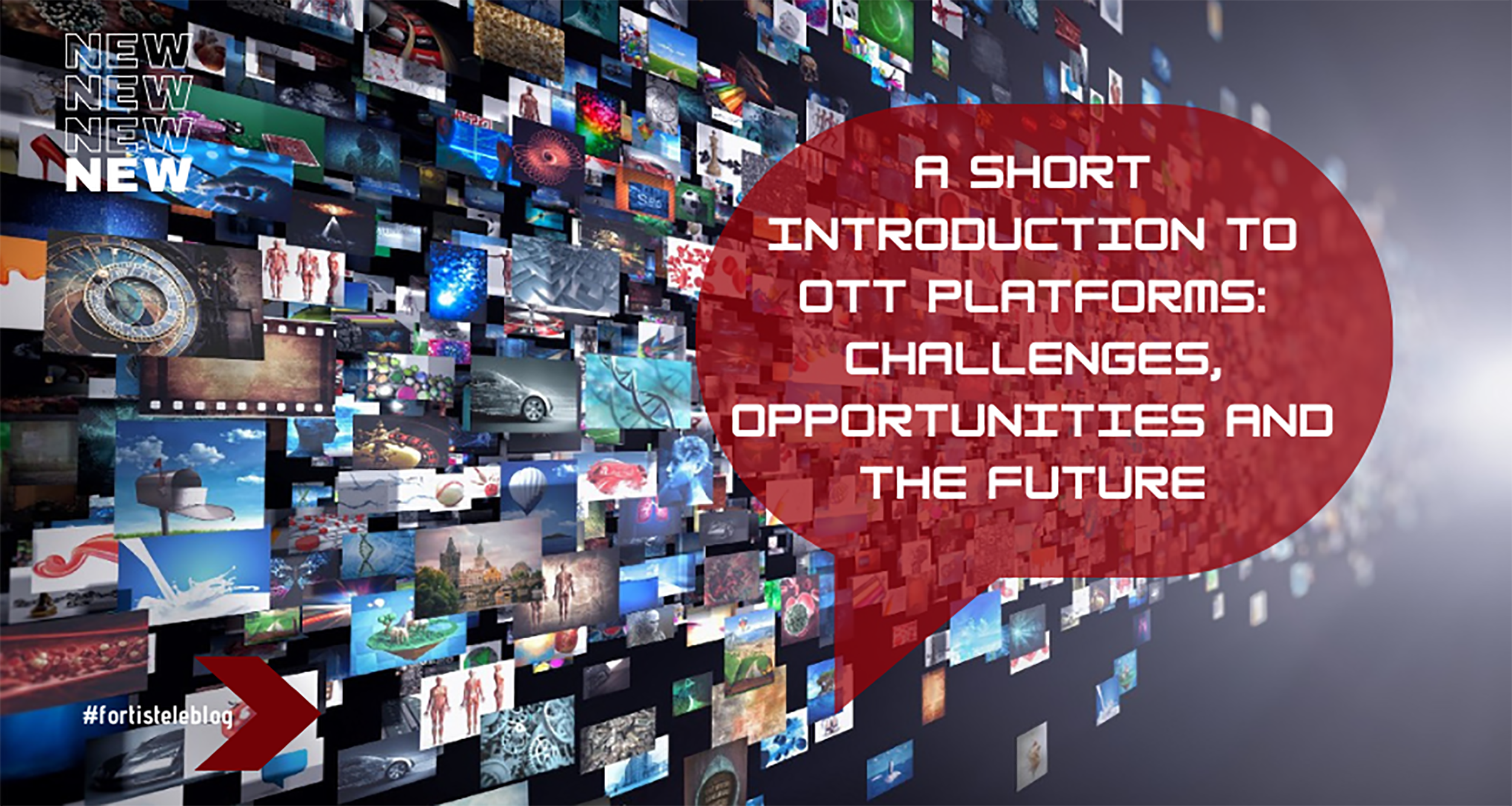Over the past two decades, there has been a monumental shift in how people access and consume video content. With the universal access to broadband internet, numerous platforms like YouTube, Netflix, HBO Go emerged and steadily grew to prominence. These platforms became successful by catering to media-hungry audiences and fitting around their increasingly hectic lifestyles.
The ages-old TV-watching experience is no longer limited to real-time nor the TV screen in the living room. Content is now consumed on laptops, tablets, handheld devices, game consoles – whenever and wherever people like.
Although not a household name in itself, OTT is the exact technology that made the streaming revolution possible. In this article we shed some light on the term, provide examples of the leading OTT platforms and explore the emerging possibilities the market offers.
What is OTT?
In general, depending on who you ask, there is usually a certain lack of consensus regarding the definition of OTT. Operators, hardware manufacturers and OTT platforms – as well as their audiences – see things differently and have other things in mind as far as OTT is concerned.
While we know the acronym OTT stands for Over The Top, there is a bit of controversy regarding what it really means:
- By most definitions known today, OTT simply refers to any video streaming service delivering content to the users over the internet. Originally, this happened alongside (or usually on top of) a traditional platform like cable TV, hence ‘over the top’. An example here is HBO Go, which in many countries was only offered as a bonus for HBO cable subscribers. This restriction no longer exists today.
- OTT could also refer to the subscription model whereby the platform (e.g. Netflix) charges the fees on top of what you’d have to pay to your ISP or cable provider… Or allows you to avoid the fees of the operator (i.e. WhatsApp is a great example here, giving its subscribers the convenience of “free” “SMS” service using their internet connection. This definition would make WhatsApp an OTT platform).
- While OTT is commonly used to denote video content, many audio services fit this definition just as well. Spotify is to music what Netflix is to TV – offering a massive trove of music via the internet connection.
What are OTT Platforms?
OTT is no longer an experiment or an internet geek’s fancy. Today, television is increasingly delivered over the internet and new media companies are joining the race towards market dominance. Netflix has been around for so long you might think its market position is unflinching. But it’s still not too late for new players to try to establish their market presence. The successes of Disney+ launched only last year but managed to exceed 28 million subscribers already.
OTT also enables access to live streaming. These work much like channels in regular TV, but the content is streamed using the Internet connection to the audience’s OTT devices / set-top boxes.
What are the opportunities of OTT?
The revenue generated by over the top (OTT) media is expected to reach 158.84 billion dollars by 2024. This is more than twice the 67.8 billion generated in 2018. In general, OTT has grown massively over the eight years, with revenues growing exponentially from 6.1 billion U.S. dollars in 2010 to over ten times that amount in 2018.
Today, the OTT industry is booming as the technology has become a dominant channel for video consumption alongside PayTV and traditional broadcast services. With a 28% Year-on-Year growth in total time spent streaming on OTT, the media revenue is expected to reach 158.84 billion dollars by 2024, more than double the 67.8 bn generated in 2018 (source: Statista).
The US SVOD market is one of the biggest in the world. It is expected there will be a dozen OTT platforms with more than 5 million paying subscribers by the year 2025.
Growth for the big players such as Amazon Prime and Netflix is bound to slow down due to intense competition from younger rivals such as Disney+ and Peacock TV. This also explains the increasingly evident content license tug-of-war going on and an increased push to produce original content – like Netflix does.
Advertising
OTT is not only a booming outlet for content providers. It’s also the advertisers’ cornucopia. Among other things, it solves some of the biggest problems with traditional TV – lack of precise targeting and attribution. The traditional TV commercials followed the “spray and pray” method. This made all advertising efforts incredibly hit or miss – it was almost impossible to measure the actual effect of the campaigns. This process is now much more streamlined and efficient in OTT.
Ad audiences in the OTT space can be precisely built and targeted super-personalized ads. This gives advertisers robust possibilities to quantify the impact and calculate ROI more accurately.
OTT services which operate on a paid subscription basis can also run ads. With tiered packages, they can allow viewers to decide whether they’re more after ad-free experiences or free, but ad-supported access.
OTT vs IPTV vs SVOD: One and the same?
With the growing number of three-letter streaming-related acronyms, it may be hard sometimes to gain a better understanding of the landscape. Specifically, there is a common confusion between OTT, VOD and IPTV.
- IPTV is television delivered using Internet Protocol (which explains the “IP” in IPTV). The video streams are usually delivered within a private network and are accessible only from devices (set-top-boxes) issued by the operator. Verizon FiOS or AT&T Uverse are examples of IPTV services. For more information about IPTV, go to another post on our blog.
- VOD – video on demand typically involves paying for each piece of content individually.
- Subscription-based video on demand services (SVOD), like traditional cable TV subscriptions, allows users to watch as much content as they want at a flat rate per month. Major services include Sky (plus its subsidiary Now TV), Amazon Prime Video, Netflix, and Hulu.
Why are white-label OTT platforms becoming popular?
The demand for a video-on-demand is growing. The easiest way to launch a service like YouTube, Netflix, or Hulu is to use a white-label solution. There are many white-label OTT offerings on the market allowing to build an own OTT service for:
- Small player launching a streaming service for a niche target group or
- An established large operator wanting to start a new OTT service to reach new customers – we have the right solution for you!
White-label makes it much easier, faster and cheaper to build OTT platforms. This model allows you to make the platform look and perform well on mobile and other devices using native apps, and gives you complete control over subscriptions and monetization strategies for your content.
Many TV broadcasters today are entering the market either by launching their own app or platform or investing in a third-party white-label OTT platform. Most of the TV cable operators will sooner or later have to invest and make their forays into the OTT industry if they want to resist the crushing pressure from the competition.
What white-label OTT solutions are there?
One of the most popular white-label OTT platforms is Uscreen VOD, which allows you to include white-label branded apps for your video content to be viewed easily on Android, iOS and AppleTV. Native apps are apps with your brand, colors, look and feel that it launched, maintained and updated by on the app stores (including Google Play and Apple Store and it is already bundled in the platform).
The leading white-label OTT providers include:
- Muvi
- Uscreen
- Dacast
Many OTT players like Netflix, Disney, NFL, and NBC have recently made investments into their proprietary OTT TV app. And the effort was very likely worthwhile as 40% of US households already use a smart device to stream content.
We’re also observing new partnerships establishing as many broadcasters want to acquire audiences and great content. Disney’s recent bid to acquire Fox and the T-Mobile/Sprint merger are great examples here. For T-Mobile, a Dish purchase would give it an instant video base through the satellite-TV offering, programming contracts with cable networks and the largest OTT service in the country, Sling TV.
In 2020, more than 65-70% of US broadband households own at least one streaming entertainment product, and 50% own a smart TV.
A competitive market
The OTT market in the US is becoming increasingly competitive as more companies are entering the market. At the same time, we are witnessing a gradual consolidation of the market.
The recent launch of Disney+ and Apple TV+ has caused some stir on the OTT market, increasing pressure not only on traditional pay-TV operators but also on incumbent SVoD platforms such as Netflix.
Disney acquired 21st Century Fox in March 2019 to position itself for a streaming-centric future and launched ESPN+ streaming service. Later on, the company also launched another service called Disney+ (that was also acquired by Hotstar in India), which includes new shows based on the Star Wars and Marvel universes and Disney’s entire movie library.
Today, many TV and internet providers are increasingly diversifying their offerings with so-called “over-the-top” (OTT) internet streaming services, such as Hulu, HBO Max, Netflix, Disney+ and Amazon Prime Video, that offer specialized content and bypass traditional cable and satellite distribution channels.
Summary
OTT has become one of the few remaining – but much-needed – sources of entertainment these days. This explains its explosive growth in the recent years – the effect is very likely compounded by the cord-cutting trends and a gradual switch to online-only media consumption. For advertisers, OTT services will soon be the only way to reach some TV audiences which don’t use regular TV, cable or IPTV.
Because OTT is still a relatively new phenomenon, it still offers great opportunities for media companies, content providers and advertisers. Lots of companies are entering the OTT space, opening new possibilities for their consumers and advertisers.





Excellent site you have here.. It’s difficult to ffind excellent writing like yours nowadays.
I honestly appreciate individuals like you! Take care!!
It’s awesome to go to see this site and reading the views of all colleagues on tthe topic of this piece of writing, while
I am also keren of getting knowledge.
I’m not that much of a online reader to be honest but your blogs really nice,
keep it up! I’ll go ahead and bookmark your site
to come back down the road. Many thanks
Also visit my site … Adana gazetesi
I’m no longer certain where you aare getting
your information, but good topic. I must spend sone time
finding out much more or figuring out more. Thanks for fantastic info I useed to be searching forr this
information for my mission.
Thanks for one’s marvelous posting! I actually enjoyed
reading it, youu might be a great author. I will remember to bookmark your
blog and will eventually come back someday. I want tto enciurage you to
continue your great work, have a nice morning!
Hi to all, the contents existing at this site are genuinely amazing for people
knowledge, well, keep up the good work fellows.